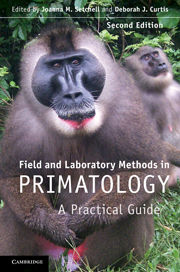Book contents
- Frontmatter
- Contents
- List of contributors
- Foreword by Robert D. Martin
- Introduction
- 1 An ethnoprimatological approach to interactions between human and non-human primates
- 2 Habituating primates: processes, techniques, variables and ethics
- 3 Habitat description and phenology
- 4 Geographical information systems and remote sensing
- 5 Monitoring local weather and climate
- 6 Survey and census methods: population distribution and density
- 7 Trapping primates
- 8 Handling, anaesthesia, health evaluation and biological sampling
- 9 Morphology, morphometrics and taxonomy
- 10 Marking and radio-tracking primates
- 11 Field experiments with non-human primates: a tutorial
- 12 Feeding ecology, frugivory and seed dispersal
- 13 Dietary analysis I: food physics
- 14 Dietary analysis II: food chemistry
- 15 Collecting arthropods and arthropod remains for primate studies
- 16 Recording primate vocalizations
- 17 Photography and video for field researchers
- 18 Chronobiological aspects of primate research
- 19 Thermoregulation and energetics
- 20 Field endocrinology: monitoring hormonal changes in free-ranging primates
- 21 Collection, storage and analysis of non-invasive genetic material in primate biology
- 22 Tips from the bush: an A–Z of suggestions for successful fieldwork
- Index
- References
7 - Trapping primates
Published online by Cambridge University Press: 05 June 2012
- Frontmatter
- Contents
- List of contributors
- Foreword by Robert D. Martin
- Introduction
- 1 An ethnoprimatological approach to interactions between human and non-human primates
- 2 Habituating primates: processes, techniques, variables and ethics
- 3 Habitat description and phenology
- 4 Geographical information systems and remote sensing
- 5 Monitoring local weather and climate
- 6 Survey and census methods: population distribution and density
- 7 Trapping primates
- 8 Handling, anaesthesia, health evaluation and biological sampling
- 9 Morphology, morphometrics and taxonomy
- 10 Marking and radio-tracking primates
- 11 Field experiments with non-human primates: a tutorial
- 12 Feeding ecology, frugivory and seed dispersal
- 13 Dietary analysis I: food physics
- 14 Dietary analysis II: food chemistry
- 15 Collecting arthropods and arthropod remains for primate studies
- 16 Recording primate vocalizations
- 17 Photography and video for field researchers
- 18 Chronobiological aspects of primate research
- 19 Thermoregulation and energetics
- 20 Field endocrinology: monitoring hormonal changes in free-ranging primates
- 21 Collection, storage and analysis of non-invasive genetic material in primate biology
- 22 Tips from the bush: an A–Z of suggestions for successful fieldwork
- Index
- References
Summary
INTRODUCTION
There are many reasons to capture study animals. They include marking or radio-collaring (Chapter 10), taking morphological measurements (Chapter 9), or biological samples (Chapters 1 and 8), and estimating age and condition. For small nocturnal primates, capture is essential to radio-tag animals for direct observation, the most effective method of determining the spatial distribution and social interactions of individuals and estimating population densities (Chapter 6; Sterling et al., 2000). Historically, studies in which wild, larger-bodied, primates are habituated for long-term observation have rarely included capture, perhaps because researchers have been understandably wary of its effects on subsequent behaviour and habituation (Chapters 2 and 11). However, a survey of more than 120 studies that combined observation with capture, and which involved about 65 primate species, showed that a careful capture–release programme using trapping will not cause a previously habituated population to change its behaviour towards human observers, and will not be associated with excess mortality or serious injury (Jolly & Phillips-Conroy, 1993 and unpublished data). Changes in ranging habits will be temporary at worst, and basic social organization and structure will not be affected. The survey also provided a comparison between capture methods. Trapping has been used most often to catch diurnal-terrestrial and nocturnal-arboreal species. Diurnal-arboreal primates (apart from callitrichines) have generally been captured by darting (Chapter 8), a bias that seems unjustified.
- Type
- Chapter
- Information
- Field and Laboratory Methods in PrimatologyA Practical Guide, pp. 133 - 146Publisher: Cambridge University PressPrint publication year: 2011
References
- 4
- Cited by

